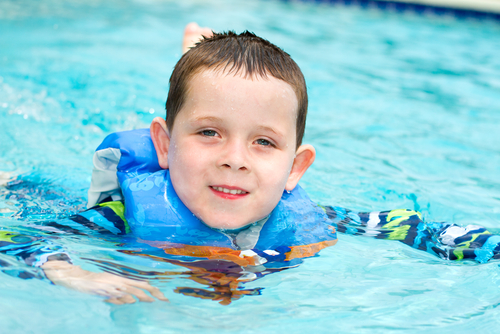
Your pool is the focal point of your backyard and provides tons of fun for you and your family. Whether you purchased a home with a pool or you decided to install a backyard pool, the most important responsibility you have is to make your pool as safe as possible for all ages.
First, check what safety measures are legally required in your community. Then, consider additional equipment and rules of behavior appropriate for the age of the children who will be using your pool. This is especially true if you have children under five years old. We’ve got a list of 10 steps you can take to help you get started to ensure that your pool is the site of a lifetime of happy memories.
Accessibility. Making your pool inaccessible when there is no adult supervision isn’t as easy as it sounds. There are a few things you can do:
If you have an above ground pool, purchase an entry ladder that can flip up and lock.
Consider alarms for all doors or windows that provide access to the pool area. There are also alarms that float in the pool and sound the alarm when anyone enters the water.
Surround your pool area with good fencing. Choose a fence that is at least four feet tall and does not have openings little feet can use as a ladder.
Make sure all gates to the pool area are self-closing, and the latches are high enough that young children can’t reach them. Put locks on the gates.
Consider purchasing a pool safety cover for your pool. This is applied whenever the pool is not in use. The best safety measure is to provide multiple barriers to accessing the pool area.
Supervision. No children should be allowed in the water unless there is an adult present. When you have a larger group in the pool, have the adults take turns being responsible for watching the kids. You could even consider hiring a lifeguard for an event that includes a number of children—like your eight-year-old’s birthday party. If your older children want to swim, they should be taught that they must use the buddy system so help is available in an emergency.
Walk. No running! When the pool deck is wet, there is the potential to slip and fall. There is no reason the kids need to run in the pool area.
Diving. Keep a strict rule of no diving unless your pool has sufficient depth for safe diving. Make sure everyone using the pool knows whether diving is allowed and what part of the pool is safe to dive in.

Safety vest. If your children are non-swimmers, they should always wear a Coast-Guard-approved safety vest while in the pool area. These are available in fun kid styles, so your children won’t resist wearing the vests. Do not rely on swim aids or floats for safety. Enroll your children in swim lessons.
Watch. Monitor their play. Injuries can occur if horseplay becomes too aggressive or if the swimming skill among the kids is significantly different. A poor swimmer could be intimidated into trying to do activities that are over his skill level and get in trouble.
Rescue equipment. Keep rescue equipment in the pool area. Equipment like a rescue hook or pole and a rescue flotation device should be readily and easily accessed in an emergency.
Become CPR-certified. Depending on the ages of your children, you can have them learn CPR, too. The more people trained in emergency techniques, the better chance of a positive outcome if it’s ever necessary to use them.

First aid. Keep a first aid kit in the pool area to treat minor cuts or scrapes and include waterproof bandages in your kit. Because you’re outside, you may want to add sunscreen and aloe to your first aid kid. Part of good first aid is prevention, so never allow glass objects of any kind by the pool area and always keep water available so no one gets dehydrated.
Phone. Always have a phone in the pool area and make sure everyone knows where the phone is to call for help if needed. The phone is of no use if it’s hidden under a pile of swim towels or still in the bedroom where you changed into your swimsuit.
Your pool is a place for fun activities and relaxation. Having rules in place and enforcing them can ensure that everyone stays safe all summer—or year—long.
 Hello Guest,
Hello Guest,  15 item(s)
15 item(s)
